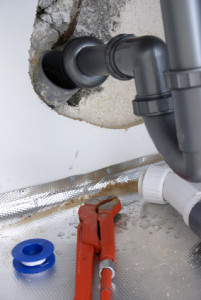Settling the score in the kitchen and bathroom
 When you think about plumbing problems, your first thought probably involves your home’s toilet. For multiple reasons, toilets tend to cause a host of visible problems with relative frequency. Meanwhile, temperature swings can cause poorly insulated pipes to burst in your basement or under your yard. However, there’s another class of plumbing problems that doesn’t get the attention it deserves: leaks, breaks and clogs in kitchen and bathroom sinks.
When you think about plumbing problems, your first thought probably involves your home’s toilet. For multiple reasons, toilets tend to cause a host of visible problems with relative frequency. Meanwhile, temperature swings can cause poorly insulated pipes to burst in your basement or under your yard. However, there’s another class of plumbing problems that doesn’t get the attention it deserves: leaks, breaks and clogs in kitchen and bathroom sinks.
Clogged Sink Drains
This is a common problem in the bathroom and kitchen. Although a slow drain may be little more than an inconvenience for intrepid homeowners, clogs can eventually cause damaging backups. Worse, they may even result in burst or leaky pipes underneath your sink. To prevent these negative effects, attack the problem as soon as it becomes apparent. If you don’t want to use harsh drain-opening chemicals, opt for a handier approach. Simply remove the spring tab, ball valve and pop-up plug from the drain and manually remove the material that’s clogging it. After replacing the parts, you should be good to go.
Poor Water Pressure
While poor water pressure isn’t necessarily the result of a clog, it does demand immediate attention. Fortunately, there’s a simple, two-step solution to this issue. First, check the hot and cold taps in succession. If pressure is low for both, the culprit is likely a calcified aerator that isn’t allowing water to flow out of the faucet head properly. Use a solvent or scraper to remove the calcium deposits from the aerator. In the worst case, you may have to purchase an entirely new faucet head.
Under-Sink Leaks
Under-sink leaks can be caused by corroded, poorly insulated or clogged pipes. By the time you notice such a leak, it’s likely to have caused significant water damage in the cabinet beneath your sink. This requires a rapid response. First, shut off your home’s water and cover the weak area with caulking or some other sealant. If this doesn’t solve the problem, you’ll have to replace the damaged segment. Once this has been resolved, clean up any excess water and moisture beneath your sink. In the subsequent days and weeks, monitor closely for mold buildup and other potential complications.
Your Source for Expert Plumbers in Austin
Do any of these plumbing problems sound familiar? Even if they don’t, it’s only a matter of time before something goes wrong with your kitchen or bathroom sink—or both. Don’t wait until serious water damage or severely corroded pipes force you to take on an ambitious, expensive repair project. For help with any sort of plumbing problems, including those described above, visit our website for a free estimate or call (512) 837-9500 at your convenience.